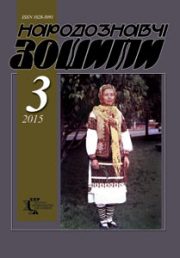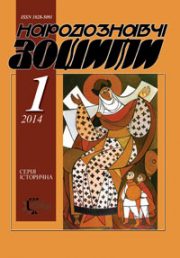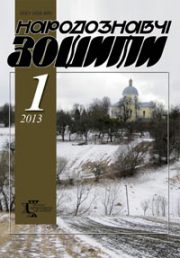The Ethnology Notebooks. 2021. № 4 (160), 971—976
UDK811.161.2’373.2:[94(477):355.318]
DOI https://doi.org/10.15407/nz2021.04.971
SEMANTIC AND MOTIVATIONAL BASIS OF UPA PSEUDONYMS
SOKIL-KLEPAR Nataliya
- ORCID: https://orcid.org/0000-0002-4156-5978
- Ph. D., Associate Professor
- of the Department of Ukrainian Language,
- Lviv Ivan Franko National University
- Universytetska Str., 1, Lviv, 79001, Ukraine
- Contacts: e-mail: nsokil@ukr.net
Abstract. Introduction:Anthroponyms are a small part of history, which reflect the lifestyle, beliefs, aspirations, fantasy, creativity, culture and mentality of the people. The system of anthroponyms is complex and multifaceted. Pseudonyms, fictitious names, the main function of which is to hide the identity are particularly interesting in terms of linguistics. The formation and use of such proper names was mainly stimulated by certain social and historical circumstances. This explains why pseudonyms were so frequently used during the national liberation movement in the 40s and 50s of the 20th century. Pseudonyms as linguistic phenomena have a number of peculiar features, for example, self-naming, optionality, secondariness, informality, nonhereditary nature, connotation, polyonymy (several pseudonyms used by one holder). The main scientific method in the article is descriptive. Results: The motivational level, the reasons for creating names and highlighting a characteristic feature that contributed to the formation of an onym, plays a particularly important role. Certainly, when it comes to pseudonyms of the fighters, they are most frequently probabilistically motivated, since it might not always be possible to find reasons for the actual motivation. Therefore, the main criteria in distinguishing the onyms for an onomatologist are usually the thematic and semantic ones. Pseudonyms semantically derive from appellatives and propriatives. Among the pseudonyms derived from appellatives, there are mostly units motivated by flora nomination, fauna nomination, ornithonomination, etc. (Birch, Beech, Cherry, Hornbeam, Oak, Raspberry, Spruce, Sycamore; Squirrel, Bear, Wolf, Hare, Snake, Lion, Duck, Swan, Bee, Gadfly; Golden Eagle, Raven, Pigeon, Thrush, Eagle, Falcon, Nightingale, Hawk). The names of wild animals most frequently formed the basis for the nomination of the fighter pseudonyms. We can assume that these names reflected the spirit of the pseudonym holders and were associatively projected onto the expression of freedom, will and boundless flight. Among other onyms analysed in the article, it is necessary to distinguish the derivatives from landscape features (Beskid, Ravine), coloratives (White, Grey, Blackness), household related vocabulary (Whip, Hammer, Pick; Bryndza; Bunda), abstract vocabulary (Horror, Revenge), etc. Among the onym-based pseudonyms, the pseudonyms derived from anthroponyms dominate, in particular, the ones derived from the names (Bohdana, Vlodko, Irka, Yarko, Mstyslav). Foreign names represent a small proportion of pseudonyms (Arnold, Alfred, Lewis). Conclusion: Thus, each pseudonym of the fighter is a historical fact of a particular epoch, created situationally for the purpose of secrecy. In terms of linguistic specifics, such units are the result of secondary nomination, which rest on a semantic and motivational basis.
Keywords: pseudonym, motivation, semantics, nomination.
Received 3.08.2021
REFERENCES
- Bachun, L.I. (2018). Something about pseudonyms of the period 1942—1954 (based on Ukrainian prose works). Naukovi zapysky Natsional’noho universytetu «Ostroz’ka akademiia». Seriia «Filolohiia» (Issue 1 (69), part 1, pp. 31—33). Retrieved from: https://journals.oa.edu.ua/Philology/article/download/1563/1382/ [in Ukrainian].
- Horbal’, M. (2005). Search guide. Register of persons involved in the liberation struggle in Drohobych 1939—1950 (according to archival documents) (Vol. 6). Toronto; L’viv [in Ukrainian].
- Zhajvoronok, V. (2006). Signs of Ukrainian ethnoculture. Dictionary-reference. Kyiv: Dovira [in Ukrainian].
- Lesiuk, M.P. (1999). Pseudo of soldiers of the Ukrainian Insurgent Army. Studia Slawistyczne 1: Nazewnictwo na pograniczach etniczno-jezykowych (Pp. 117—184).Bialystok [in Ukrainian].
- Mirchuk, P. (1991). Ukrainian Insurgent Army. 1942—1952. L’viv [in Ukrainian].
- Pavlykivs’ka, N.M. (2009). Questions of Ukrainian pseudonymy of the twentieth century. Vinnytsia: Hlobus-Pres [in Ukrainian].
- Pavlykivs’ka, N.M. (2011). System and structure of OUN and UPA pseudonyms. Naukovyj chasopys Natsional’noho pedahohichnoho universytetu imeni M.P. Drahomanova. Seriia 10: Problemy hramatyky i leksykolohii ukrains’koi movy (Issue 7, pp. 274—279). Retrieved from: http://nbuv.gov.ua/UJRN/Nchnpu_10_2011_7_63 [in Ukrainian].
- Pavlykivs’ka, N.M. (2007). Dictionary of pseudonyms OUN-UPA. Vinnytsia: O. Vlasiuk [in Ukrainian].
- Red’ko, Yu.K. (1966). Modern Ukrainian surnames. Kyiv: Naukova dumka [in Ukrainian].
- Selivanova, O.O. (2008). Modern linguistics: directions and problems. Poltava: Dovkillia-K [in Ukrainian].
- Kotsur V.P., Potapenko O.I., & Dmytrenko M.K. (Eds.). (2002). Dictionary of symbols of Ukrainian culture. Kyiv: Milenium [in Ukrainian].
- Buchko, D., & Tkachova N. (Eds.). (2012). Dictionary of Ukrainian onomastic terms. Kharkiv: Ranok-NT [in Ukrainian].
- Sokil, N. (1999). Pseudonyms of insurgents of Skole. Vyzvol’nyj shliakh (Book 6 (615), pp. 717—734).London; Kyiv [in Ukrainian].
- Chuchka, P.P. (2001). Ukrainian pseudonyms: status, structure and functions. Naukovi zapysky Kirovohrads’koho derzh. peduniversytetu im. V. Vynnychenka. Seriia: filol. nauky (movoznavstvo) (Issue 37, pp. 82—83) [in Ukrainian].






